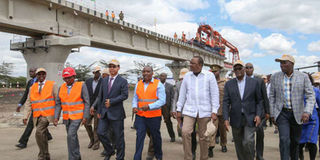Uhuru calls for speedy completion of railway line

President Uhuru Kenyatta (third right) with Transport and Infrastructure Cabinet Secretary James Macharia (second right) and Kajiado Governor Joseph ole Lenku during an inspection tour of the Nairobi to Naivasha Standard Gauge Railway Phase 2A Project at DK2 project site at the Inland Container Deport on June 23, 2018. PHOTO | FRANCIS NDERITU | NATION MEDIA GROUP
What you need to know:
The 120km stretch was launched in October 2016 and will traverse five counties of Nairobi, Kajiado, Kiambu, Nakuru and Narok.
It is an extension of the Sh327 billion Mombasa-Nairobi SGR project.
- Chen Yun, the Vice President of the Chinese company said he will work within the contractual obligation and ensure the completion is in time.
President Uhuru Kenyatta has challenged the company constructing the second phase of Nairobi- Naivasha Standard Gauge Railway to ensure it is completed on time so that he can use it to Kajiado for next year’s Madaraka Day celebrations.
This came as the president told the management of the Communications Construction Company (CCC), a Chinese firm, to stick to the completion date of June 2019 in line with the agreement signed with the Kenyan government.
The project will cost Sh150 billion and is co-financed by the Kenyan and Chinese governments.“We want to ride on the Nairobi-Naivasha SGR on May 31 next year, and then go to Kajiado for Madaraka Day the next day,” said President Kenyatta.
The President spoke at Kyang’ombe in Embakasi, Nairobi where he witnessed the installation of bridge girders across the Nairobi National Park which is a critical part of the ongoing extension of the line.
OBLIGATION
President Kenyatta later held a closed-door inter-ministerial meeting at the site and left without making any public comment.
The 120km stretch was launched in October 2016 and will traverse five counties of Nairobi, Kajiado, Kiambu, Nakuru and Narok.
It is an extension of the Sh327 billion Mombasa-Nairobi SGR project.
Speaking at the event, Chen Yun, the Vice President of the Chinese company said he will work within the contractual obligation and ensure the completion is in time.
“We look out to complete the Nairobi to Naivasha SGR by June 2019. We will also employ more residents of Kajiado and Narok counties where the rail is passing through,” Mr Yun said.
The project is currently 49 per cent complete.
However, compensation of landowners has been the main challenge with the National Lands Commission on the spot.
DECONGESTION
NLC chairman Mr Muhammad Swazuri, who was also present, has been interrogated by MPs on a number of occasions.
Already, Public Accounts Committee of the National Assembly has directed Auditor General Edward Ouko to conduct a special audit on the compensation of land along the SGR corridor. The report is expected in the next few days.
But addressing the issue yesterday, Transport and Infrastructure Cabinet Secretary James Macharia said mechanisms have been put in place where aggrieved citizens can seek legal redress without delaying the project.
“People can go to court to seek resolution of disputes around compensation but time-bound projects where delays cost heavy financial loses should be allowed to progress,” Mr Macharia said.
Apart from opening up areas for development, the Nairobi-Naivasha stretch is also geared towards decongesting the accident-prone highway between the two towns.
CREATE JOBS
Among the projects lined up to benefit from the current extension of the SGR is the proposed Special Economic Zones (SEZs) in Suswa and Mai Mahiu.
Further, the project is hoped to boost tourism, agro-processing and industrial development in the geothermal-rich Rift Valley.
Some of the key aspects along the project include 27 bridges, three tunnels and four stations in Rongai, Ngong’, Mai Mahiu and Suswa.
It will have a capacity to handle 250 passengers daily.
The ongoing construction has created a total of 22,000 direct and indirect jobs covering both skilled and unskilled labour.
Its completion will lead to its extension to Malaba and the other East African countries of Uganda, Rwanda, Rwanda and possibly Burundi and the Democratic Republic of Congo.
Once completed, it will deliver safe, efficient and cost-effective railway transport, decongest the port of Mombasa, and facilitate easy access to local and foreign markers for produce from Kenya’s hinterland.





